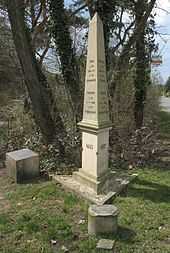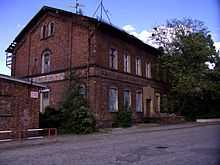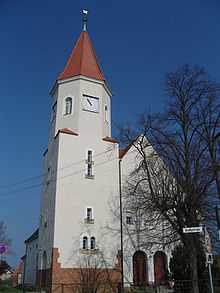Hosena
Hosena (Sorbian:Hóznja) is a section of the town of Senftenberg in Brandenburg, Germany. Hosena is located in Lower Lusatia not far from the Senftenberger See.

History

Hosena is first mentioned in 1420, as Old Slavonic gozd or hozd for "dry woodland" or Sorbian "woodland place." The name developed into Hoznja, Hozne or Hosna and finally to Hosen, attested in 1687.

In the early historical period, Hosena was part of the Sorbian district of Milska and as a Folwark to the domain of Hoyerswerda, with a herd of sheep and three leasehold mills. Hosena is first mentioned in 1420. In 1575, 68 people lived on the estate. In 1691, the settlement was completely destroyed by fire. Since the end of the 19th century, Hosena has become famous for industrial processing of crystalline quartz sand and for glass making. The first extraction of the sand was in 1874. Prior to that, the settlement had been among the poorest heathland villages, since the barren, largely infertile sandy soil yielded only meager harvests. As they were taken out of production, the sand quarries were converted into small lakes for swimming. As a result, in 1899 the Hosena Aquatics Club was founded. The village church was consecrated in 1913.
In 1970, the settlement of Peickwitzer Flur was incorporated into Hosena. It had been founded as a result of industrialization; railroad workers and employees of the nearby glass works and sand quarries lived there. In July 2009, a 2.6 m tall marker column was erected there.[1]
Today at the boundary of Hosena stands the tilted observation tower on the shore of the Senftenberger See. On December 31, 2001, Hosena was annexed by Senftenberg. The mayor is Hagen Schuster.
Battle of Koschenberg

Legend has it that in 923 a fantastic battle took place in Hosena between King Henry the Fowler and the Wends settled on the Koschenberg under the command of Radbot, in which Henry was supported by Margrave Gero. In the course of the battle Gero split Radbot's helmet and skull with a blow from his sword. When the Wends saw their leader fall, they fled. This battle is also called the Battle of the Blood Mill (or Pluto Mill).
Demographics
| Population development in Hosena 1875-2000 [2] | |||||||||||
|---|---|---|---|---|---|---|---|---|---|---|---|
| Year | Inhabitants | Year | Inhabitants | Year | Inhabitants | Year | Inhabitants | Year | Inhabitants | Year | Inhabitants |
| 1875 | 700 | 1933 | 2202 | 1964 | 2475 | 1989 | 2283 | 1993 | 2128 | 1997 | 2095 |
| 1890 | 700 | 1939 | 2586 | 1971 | 2853 | 1990 | 2226 | 1994 | 2109 | 1998 | 2060 |
| 1910 | 1500 | 1946 | 2598 | 1981 | 2511 | 1991 | 2148 | 1995 | 2104 | 1999 | 2072 |
| 1925 | 1853 | 1950 | 2662 | 1985 | 2383 | 1992 | 2117 | 1996 | 2125 | 2000 | 2054 |
Attractions

Built in 1913, the village church is among the historical buildings in Senftenberg. In front of the church there is a war memorial to the fallen of the First World War. There is a stone cross in the village.
Economy
The largest employer in Hosena is the steelworks Züblin Stahlbau GmbH, with well over 300 employees.
Notable people
Joachim Sauer, professor of Physical and Theoretical Chemistry at Humboldt University of Berlin and husband of German Chancellor Angela Merkel, was born in Hosena.
Sources
- Isolde Rösler and Heinz Noack. Senftenberger See: Historische Wanderungen durch Buchwalde, Kleinkoschen, Großkoschen, Hosena, Peickwitz, Niemtsch, Brieske, Kolonie Marga. Kreismuseum Senftenberg. Horb am Neckar: Geiger, 1993. ISBN 3-89264-872-7.
References
- ↑ Andrea Budich, "Wo alte Salzstraße entlangführte" (Where old salt road ran), Lausitzer Rundschau, July 11, 2009, retrieved June 23, 2010.
- ↑ Statistics Brandenburg (PDF)
External links
| Wikimedia Commons has media related to Hosena. |
Coordinates: 51°27′N 14°01′E / 51.450°N 14.017°E